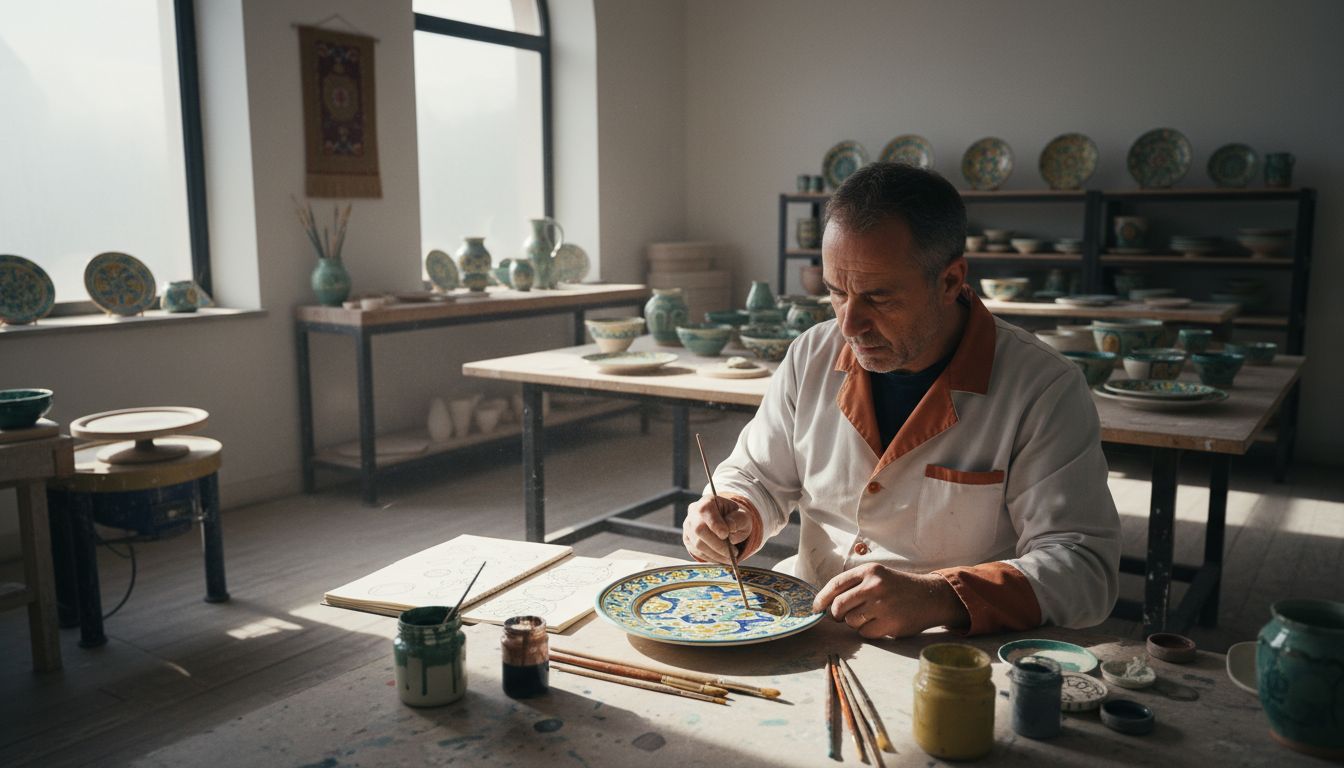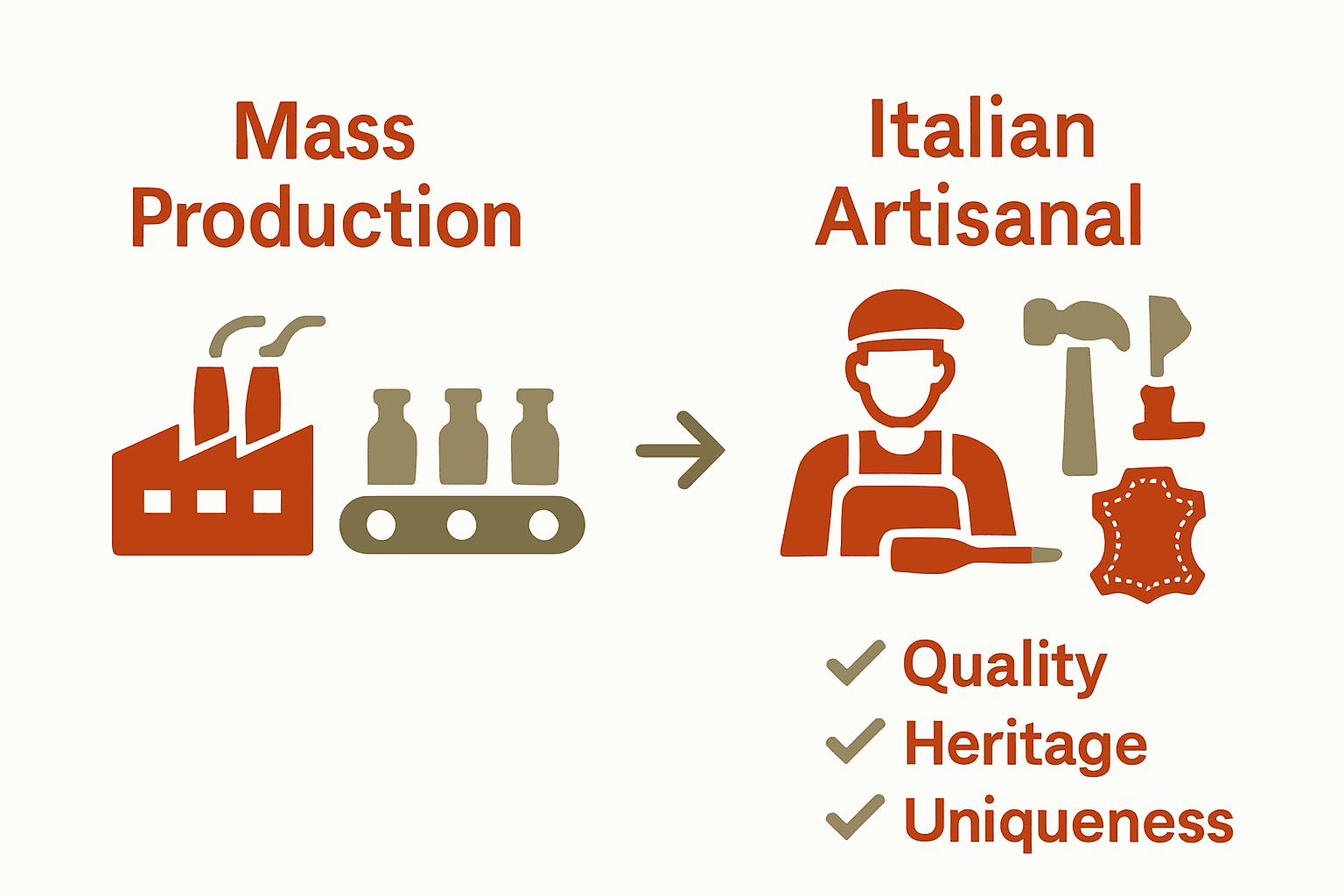
What Is Italian Craftsmanship? Complete Guide
Share
Most luxury goods fade with trends, but Italian craftsmanship stands as a living legacy, rooted in a rich history where over 80 percent of artisans still use techniques passed down for generations. This tradition weaves artistic beauty, technical mastery, and cultural pride into every detail, making each handcrafted piece more than just a product. Explore how Italian artisans transform simple materials into stories of heritage, skill, and enduring value.
Table of Contents
- Defining Italian Craftsmanship And Heritage
- Traditional Materials And Artisanal Techniques
- Key Sectors: Leather, Fashion, And Home Decor
- How To Identify Authentic Italian-Made Goods
- Benefits And Value Of Supporting Artisans
Key Takeaways
| Point | Details |
|---|---|
| Cultural Heritage | Italian craftsmanship embodies centuries of artistic tradition and technical skill, crucial for the luxury sector’s value creation. |
| Artisanal Techniques | Authentic Italian-made goods showcase meticulous craftsmanship, utilizing premium materials and traditional methods passed down through generations. |
| Support for Artisans | Supporting artisans promotes cultural preservation, economic sustainability, and unique quality in products, contrasting mass production. |
| Identifying Authenticity | Genuine Italian luxury items can be discerned by their material quality, craftsmanship details, and transparent production processes. |
Defining Italian Craftsmanship And Heritage
Italian craftsmanship represents more than just a manufacturing process - it’s a profound cultural legacy that blends centuries of artistic tradition, technical skill, and unparalleled attention to detail. Artisanal expertise has been a cornerstone of Italian culture since the Renaissance, where master craftsmen transformed simple materials into extraordinary works of art and functional design.
According to research from Unitesi University, the preservation of cultural heritage through craftsmanship is fundamental to value creation in the luxury sector. This approach goes beyond mere production, emphasizing the independence and autonomy of historical artisan enterprises that have maintained their unique techniques across generations.
The essence of Italian craftsmanship can be distilled into several key principles:
- Generational Knowledge: Skills passed directly from master to apprentice
- Exceptional Material Selection: Using only premium, high-quality materials
- Meticulous Handwork: Prioritizing manual techniques over mass production
- Aesthetic Precision: Combining functional design with stunning visual beauty
As explored in the University of California’s course Italy’s Artistic Heritage Through Craftsmanship and Luxury, this tradition of craftsmanship stretches back to the fifteenth century, representing a continuous narrative of artistic and technical excellence that has defined Italian luxury and creativity for centuries. Each handcrafted piece tells a story - not just of its creation, but of a rich cultural heritage that values skill, patience, and an unwavering commitment to quality.
Traditional Materials And Artisanal Techniques
Italian craftsmanship is intrinsically linked to the extraordinary materials and time-honored techniques that have been perfected over centuries, transforming simple raw materials into extraordinary works of functional art. From premium full-grain leather to exquisite ceramics, each material is selected with remarkable precision and treated with profound respect for its inherent qualities.
Ceramic artistry represents one of the most remarkable expressions of Italian traditional craftsmanship. Wikipedia highlights the rich heritage of maiolica, a traditional Italian tin-glazed pottery decorated with vibrant colors on a white background, tracing its origins back to the Renaissance period. These intricate ceramic techniques showcase the extraordinary skill of Italian artisans who transform clay into stunning, narratively rich pieces.
Traditional materials in Italian craftsmanship typically include:
- Full-Grain Leather: Highest quality, unaltered leather with natural grain intact
- Fine Ceramics: Tin-glazed pottery with intricate hand-painted designs
- Premium Metals: Carefully selected and expertly worked metals
- Natural Textiles: Carefully sourced wool, silk, and cotton
In the ceramic tradition, cities like Faenza have become synonymous with exceptional craftsmanship. As Wikipedia notes, Faenza ceramics are characterized by painted decorations on white glaze, often featuring Renaissance, naturalistic, or geometric motifs that reflect generations of artistic heritage. These pieces are not merely decorative objects, but tangible connections to Italy’s rich cultural narrative, where each brushstroke and glaze represents centuries of accumulated knowledge and artistic expression.

Key Sectors: Leather, Fashion, And Home Decor
Italian craftsmanship spans multiple extraordinary sectors, each representing a unique expression of cultural heritage and exceptional skill. Leather, fashion, and home decor stand as the most celebrated domains where Italian artisans transform raw materials into objects of extraordinary beauty and functionality.
In the leather industry, Italian craftspeople are renowned for their meticulous attention to detail and commitment to premium materials. The Future of the Italian Leather Industry: Trends & Insights highlights how traditional techniques continue to evolve while maintaining core principles of quality and precision.
Home decor represents another pinnacle of Italian craftsmanship. As explored in research from Unitesi University, artisanal enterprises like Martina Vidal Venezia play a crucial role in preserving cultural heritage through intricate production techniques. Wikipedia further illuminates this sector, noting how high-end manufacturers like Frette utilize premium materials such as long staple cotton, silk, and cashmere, often employing both antique and modern jacquard looms.
Key characteristics of these sectors include:
- Leather: Handcrafted accessories, precision cutting, premium material selection
- Fashion: Haute couture techniques, bespoke tailoring, intricate embellishments
- Home Decor: Artisanal textile production, complex weaving techniques, heritage design
These sectors are not merely industries - they are living embodiments of a cultural narrative that celebrates creativity, skill, and an unwavering commitment to exceptional craftsmanship. Each piece tells a story of generations of artisans who have refined their techniques, transforming simple materials into objects of extraordinary beauty and lasting value.
How To Identify Authentic Italian-Made Goods
Authenticity in Italian-made goods is a nuanced art that goes far beyond simple labels or marketing claims. Genuine craftsmanship requires a discerning eye and understanding of the intricate details that distinguish truly exceptional pieces from mass-produced imitations.
For leather goods, Complete Guide to Spotting Genuine Italian Leather offers critical insights into identifying authentic pieces. Look for hallmarks like impeccable stitching, premium full-grain leather with natural variations, and meticulous attention to every minute detail.
In the ceramic world, authenticity is deeply rooted in regional traditions and specific production techniques. Wikipedia highlights how certain ceramics are legally protected as denominations of origin, ensuring their authenticity and quality. Similarly, Lodi ceramics research demonstrates the importance of specific materials like Stradella clay and traditional techniques such as tin-glazing and double firing.
Key indicators of authentic Italian-made goods include:
- Material Quality: Premium, unaltered materials with natural characteristics
- Craftsmanship Details: Hand-finished edges, precise stitching, minimal machine intervention
- Provenance Markers: Genuine maker’s marks, regional certification stamps
- Textural Authenticity: Natural variations that demonstrate handmade origin
- Production Transparency: Traceable manufacturing process and artisan heritage
Authentic Italian-made goods tell a story - each imperfection is a testament to human skill, not a flaw.
They represent a commitment to preserving cultural heritage, where every stitch, brushstroke, and material selection reflects generations of refined expertise.
Benefits And Value Of Supporting Artisans
Supporting artisanal craftspeople is far more than a purchasing decision - it’s a commitment to preserving cultural heritage, sustaining traditional skills, and investing in extraordinary quality. Artisan support represents a profound connection between consumers and the rich cultural narratives embedded in each handcrafted piece.
Research from Unitesi University underscores the critical importance of supporting independent artisans like Martina Vidal Venezia. These craftspeople play a vital role in maintaining high-quality craftsmanship and differentiating products in an increasingly homogenized global marketplace. By choosing artisan-made goods, consumers directly contribute to preserving unique cultural traditions that might otherwise be lost to mass production.
The University of California’s course on Italy’s Artistic Heritage Through Craftsmanship and Luxury further emphasizes how supporting artisans is fundamental to sustaining Italy’s renowned reputation for excellence. This support goes beyond economic transactions - it’s about maintaining a living, breathing cultural legacy.
Key benefits of supporting artisan craftsmanship include:
- Cultural Preservation: Protecting traditional skills and generational knowledge
- Economic Sustainability: Directly supporting independent makers and local communities
- Unique Quality: Accessing products with unparalleled attention to detail
- Ethical Consumption: Choosing handmade over mass-produced goods
- Personal Connection: Owning items with authentic human stories
When you choose an artisan-crafted piece, you’re not just buying an object - you’re becoming part of a centuries-old narrative of skill, creativity, and human connection. Each handcrafted item carries the energy, expertise, and passion of its creator, transforming a simple purchase into a meaningful cultural exchange.

Discover Authentic Italian Craftsmanship with San Rocco Italia
Understanding the true value of Italian craftsmanship means recognising the dedication to generational knowledge, premium materials like full-grain leather, and meticulous handwork that goes into every piece. If you seek timeless luxury that honours these traditions while offering modern elegance, San Rocco Italia is here to help. Our collection features handcrafted handbags and accessories made by skilled Italian artisans who embody the very principles highlighted in the article.

Explore our exquisite range today at San Rocco Italia and embrace the unique quality and cultural heritage behind each creation. By choosing our artisan-crafted goods, you not only invest in exceptional style but also support the preservation of classic techniques and authentic craftsmanship. Start your journey to owning genuine Italian luxury now and experience the difference that passion and skill can make.
Frequently Asked Questions
What defines Italian craftsmanship?
Italian craftsmanship is characterized by generational knowledge, exceptional material selection, meticulous handwork, and aesthetic precision. It encompasses a rich cultural legacy where artisans transform materials into works of beauty and functional design.
What are the traditional materials used in Italian craftsmanship?
Traditional materials in Italian craftsmanship include full-grain leather, fine ceramics, premium metals, and natural textiles like wool, silk, and cotton. These materials are chosen for their quality and are often used in various artisanal creations.
How can I identify authentic Italian-made goods?
To identify authentic Italian-made goods, look for high-quality materials, exceptional craftsmanship details, provenance markers such as genuine maker’s marks, and evidence of a traceable manufacturing process. Authentic pieces will often show natural variations that reflect handmade origins.
What are the benefits of supporting artisanal craftspeople?
Supporting artisanal craftspeople helps preserve cultural heritage and sustain traditional skills. It also promotes economic sustainability within local communities, ensures unique product quality, encourages ethical consumption, and fosters personal connections to uniquely crafted items.


